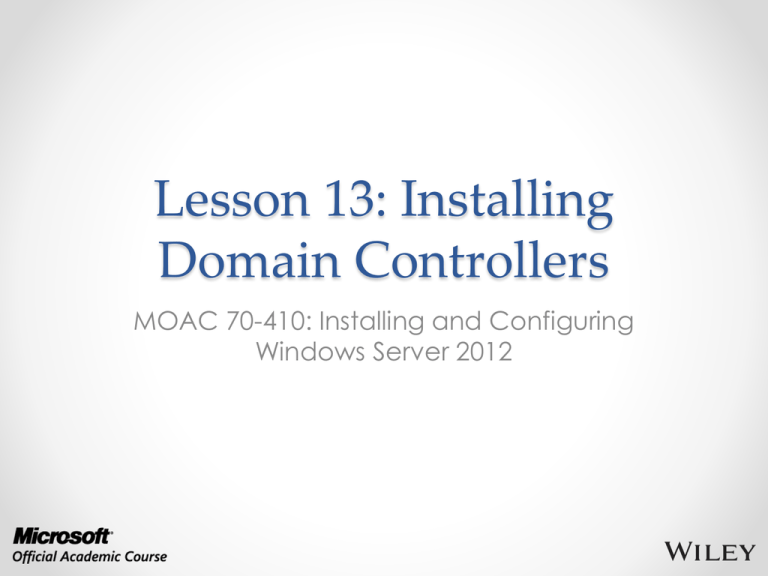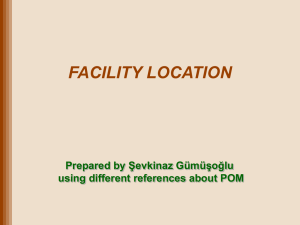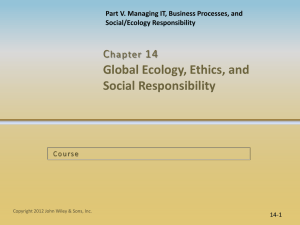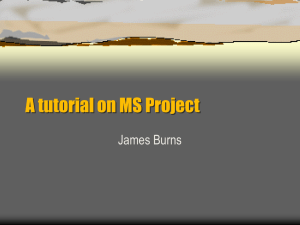
Lesson 13: Installing
Domain Controllers
MOAC 70-410: Installing and Configuring
Windows Server 2012
Overview
• Exam Objective 5.1: Install Domain
Controllers
• Introducing Active Directory
• Deploying Active Directory Domain Services
© 2013 John Wiley & Sons, Inc.
2
Introducing Active
Directory
Lesson 13: Installing Domain Controllers
© 2013 John Wiley & Sons, Inc.
3
Introducing Active
Directory
• A directory service is a repository of
information about the resources—hardware,
software, and human—that are connected
to a network.
• Users, computers, and applications
throughout the network can access the
repository for a variety of purposes:
o User authentication
o Storage of configuration data
o Accessing files and printers
© 2013 John Wiley & Sons, Inc.
4
Active Directory Domain
Services (AD DS)
• AD DS is a directory service that enables
administrators to create organizational
divisions called domains
• A domain is a logical container of network
components, hosted by at least one server
designated as a domain controller.
© 2013 John Wiley & Sons, Inc.
5
Active Directory
Functions
• Authentication is the process of verifying a
user’s identity by using:
o Passwords
o Smart cards
o Biometrics (fingerprint scan)
• Authorization is the process of granting the
user access only to the resources he or she is
permitted to use by using:
o ACLs and ACEs
© 2013 John Wiley & Sons, Inc.
6
The Active Directory
Architecture
• Active Directory is a hierarchical directory
service, based on the domain, which is scalable
in both directions.
• You can subdivide a domain into organizational
units and populate it with objects.
• You can create multiple domains and group
them into sites, trees, and forests.
• AD DS provides a highly flexible architecture
that can accommodate the smallest and the
largest organizations.
© 2013 John Wiley & Sons, Inc.
7
Objects and Attributes
• An AD DS domain is a hierarchical structure that
takes the form of a tree, much like a file system.
• Consists of objects, each of which represents a
logical or physical resource.
• Each object consists of attributes which store
information about the object.
• Different objects have different attributes,
depending on their function.
• The directory schema defines the attributes for
each object and the information that is
required and optional.
© 2013 John Wiley & Sons, Inc.
8
Classes of Objects
A container object can
have other objects
subordinate to it:
• Domain
• Organizational unit
© 2013 John Wiley & Sons, Inc.
A leaf object cannot
have subordinate
objects:
• Users
• Computers
• Groups
• Applications
• Network resources
9
Objects and Attributes
The attributes of a user object, as displayed in its
Properties sheet
© 2013 John Wiley & Sons, Inc.
10
Domains
• You can create a hierarchy within a
domain.
• You can create a hierarchy out of multiple
domains.
• You begin the process of designing an
Active Directory infrastructure by deciding
what domains to create and you begin
deploying AD DS by creating your first
domain.
© 2013 John Wiley & Sons, Inc.
11
Organizational Units (OUs)
• Are container objects within a domain, used to
divide the security and administrative
responsibility among several divisions or
departments
• Function in a subordinate capacity to a
domain, like a subdomain, but without the
complete separation of security policies
• Can contain other OUs, as well as leaf objects
• Can have separate Group Policy settings
applied to them
© 2013 John Wiley & Sons, Inc.
12
Organizational Units
Organizational units subordinate to a domain
© 2013 John Wiley & Sons, Inc.
13
Groups
• Group objects contain users (from a single or
multiple domains or OUs) who require similar
access to resources or rights to perform
tasks.
• Members of a group inherit rights and
permissions assigned to the group.
© 2013 John Wiley & Sons, Inc.
14
Domain Trees (1)
• When you create your first domain on an
Active Directory network, you are creating
the root of a domain tree.
• You can populate the tree with additional
domains, as long as they are part of the
same contiguous namespace.
• When using registered Internet domain
names, subdomains can be used to create
other domains within the domain tree.
© 2013 John Wiley & Sons, Inc.
15
Domain Trees (2)
• You can add as many domains to the tree as
you need.
• Each domain in a tree is a separate security
entity with its own separate Group Policy
settings, permissions, and user accounts.
• Unlike OUs, subdomains in a tree do not inherit
permissions and policies from their parent
domains.
• Domains in the same tree have bidirectional
trust relationships between them, which means
that an administrator of a particular domain
can grant any user in the tree access to that
domain’s resources.
© 2013 John Wiley & Sons, Inc.
16
Domain Trees
An internal Active Directory domain tree
© 2013 John Wiley & Sons, Inc.
17
Domain Trees
An Active Directory domain tree using an Internet
domain name
© 2013 John Wiley & Sons, Inc.
18
Forests
• An Active Directory forest consists of one or
more separate domain trees, which have
the same two-way trust relationships
between them as two domains in the same
tree.
• When you create the first domain on an
Active Directory network, you are creating a
new forest, and that first domain becomes
the forest root domain.
© 2013 John Wiley & Sons, Inc.
19
Global Catalog
Each forest has a global catalog, which is a list
of all of the objects in the forest, along with a
subset of each object’s attributes.
© 2013 John Wiley & Sons, Inc.
20
Functional Levels
• Functional levels are designed to provide
backwards compatibility in AD DS
installations with domain controllers running
various versions of the Windows Server
operating system.
• By selecting the functional level representing
the oldest Windows version running on your
domain controllers, you disable the new
features so that the various domain
controllers can interoperate properly.
© 2013 John Wiley & Sons, Inc.
21
Functional Levels
Raising functional levels
© 2013 John Wiley & Sons, Inc.
22
Active Directory
Communications
• Active Directory services are implemented in
the network’s domain controllers.
• Each domain controller hosts one domain,
storing the domain’s objects in a database.
• Users and computers that are members of a
domain access the domain controller
frequently, as they log on to the domain and
access domain resources.
• You should have at least two domain controllers
to ensure the Active Directory database is
available to clients at all times.
© 2013 John Wiley & Sons, Inc.
23
Introducing LDAP
• Lightweight Directory Access Protocol
(LDAP) has become the standard
communications protocol for directory
service products, including Active Directory.
• Defines the format of the queries that Active
Directory clients send to domain controllers.
• Provides a compound naming structure for
uniquely identifying objects in the directory.
© 2013 John Wiley & Sons, Inc.
24
Replication
• Replication is when domain controllers within
a domain synchronize their database
information.
• It is imperative that each domain controller
has a database that is identical to the
others.
© 2013 John Wiley & Sons, Inc.
25
Types of Replication
• Single-master replication: A single primary
system replicates the contents of its
database to one or more secondary systems
on the network.
• Multiple-master replication: It is possible to
make changes to domain objects on any
domain controller, which replicates those
changes to all of the other domain
controllers.
© 2013 John Wiley & Sons, Inc.
26
Replication
Single-master replication
© 2013 John Wiley & Sons, Inc.
27
Replication
Multiple-master replication
© 2013 John Wiley & Sons, Inc.
28
Read-Only Domain
Controllers (RODCs)
• A domain controller that supports only
incoming replication traffic.
• It is not possible to create, modify, or delete
Active Directory objects.
• Intended for use in locations that require a
domain controller, but which have less
physical security or where there are no
administrators present who need read/write
access to the Active Directory database.
© 2013 John Wiley & Sons, Inc.
29
Sites (1)
• A site is a collection of subnets that have
good connectivity between them.
• Generally speaking, this means that a site
consists of all the local area networks (LANs)
at a specific location.
• A different site would be a network at a
remote location, connected to the other
site using a T-1 or a slower WAN technology.
© 2013 John Wiley & Sons, Inc.
30
Sites (2)
• Site divisions are wholly independent of
domain, tree, and forest divisions:
o You can have multiple sites that are part of a
single domain.
o You can have separate domains, trees, or forests
for each site.
• The primary reason for creating different
sites on an Active Directory network is to
control the amount of traffic passing over
the relatively slow and expensive WAN links
between locations.
© 2013 John Wiley & Sons, Inc.
31
Site Topology
A site topology consists of three AD DS object
types:
• Sites: A site object represents the group of
subnets at a single location, with good
connectivity.
• Subnets: A subnet object represents an IP
network at a particular site.
• Site links: A site link object represents a WAN
connection between two sites.
© 2013 John Wiley & Sons, Inc.
32
AD DS Regulatory
Functions
Once the site topology is in place you can
make decisions about:
• Domain controller location
• Replication traffic control
© 2013 John Wiley & Sons, Inc.
33
Deploying Active Directory
Domain Services
Lesson 13: Installing Domain Controllers
© 2013 John Wiley & Sons, Inc.
34
Deploying AD DS
There are many variables that can affect the
performance of an Active Directory
installation:
• The hardware you select for your domain
controllers
• The capabilities of your network
• The types of WAN links connecting your
remote sites
© 2013 John Wiley & Sons, Inc.
35
Installing the AD DS Role
The Add features that are required dialog box in the
Add Roles and Features Wizard
© 2013 John Wiley & Sons, Inc.
36
Installing the AD DS Role
The Installation progress page in the Add Roles and
Features Wizard
© 2013 John Wiley & Sons, Inc.
37
Creating a New Forest
The Deployment Configuration page of the Active
Directory Domain Services Configuration Wizard
© 2013 John Wiley & Sons, Inc.
38
Creating a New Forest
The Domain Controller Options page of the Active
Directory Domain Services Configuration Wizard
© 2013 John Wiley & Sons, Inc.
39
Creating a New Forest
The Additional Options page of the Active Directory
Domain Services Configuration Wizard
© 2013 John Wiley & Sons, Inc.
40
Creating a New Forest
The Paths page of the Active Directory Domain Services
Configuration Wizard
© 2013 John Wiley & Sons, Inc.
41
Creating a New Forest
The Prerequisites Check page of the Active Directory
Domain Services Configuration Wizard
© 2013 John Wiley & Sons, Inc.
42
Adding a Domain Controller to an
Existing Domain
The Select a domain from the forest page of the Active
Directory Domain Services Configuration Wizard
© 2013 John Wiley & Sons, Inc.
43
Adding a Domain Controller to an
Existing Domain
The Domain Controller Options page of the Active
Directory Domain Services Configuration Wizard
© 2013 John Wiley & Sons, Inc.
44
Adding a Domain Controller to an
Existing Domain
The Additional Options page of the Active Directory
Domain Services Configuration Wizard
© 2013 John Wiley & Sons, Inc.
45
Creating a New Child Domain
in a Forest
The Deployment Configuration page of the Active
Directory Domain Services Configuration Wizard
© 2013 John Wiley & Sons, Inc.
46
Creating a New Child Domain
in a Forest
The Domain Controller Options page of the Active
Directory Domain Services Configuration Wizard
© 2013 John Wiley & Sons, Inc.
47
Installing AD DS on
Server Core
• In Windows Server 2012, it is now possible to
install Active Directory Domain Services on a
computer running the Server Core
installation option and promote the system
to a domain controller, all using Windows
PowerShell.
• To Install the AD DS role, use the following
command:
Install-WindowsFeature –name AD-DomainServices -IncludeManagementTools
© 2013 John Wiley & Sons, Inc.
48
Installing AD DS on
Server Core
After installing the role, you must promote the
server to a domain controller using the
ADDSDeployment PowerShell module.
There are three separate cmdlets for the three
deployment configurations:
• Install-AddsForest
• Install-AddsDomainController
• Install-AddsDomain
© 2013 John Wiley & Sons, Inc.
49
Installing AD DS on Server Core
Syntax for the Install-AddsForest cmdlet in
Windows PowerShell
© 2013 John Wiley & Sons, Inc.
50
Installing AD DS on
Server Core
Another way to do this is to use a computer
running Windows Server 2012 with the full
GUI option to generate a script.
Begin by running the Active Directory Domain
Services Configuration Wizard, configuring
all of the options with your desired settings.
When you reach the Review Option page,
click the View Script button to display the
PowerShell code for the appropriate
cmdlet.
© 2013 John Wiley & Sons, Inc.
51
Installing AD DS on Server Core
An installation script generated by the Active Directory
Domain Services Configuration Wizard
© 2013 John Wiley & Sons, Inc.
52
Install from Media (IFM)
• Install from media is an option that enables
administrators to streamline the process of
deploying replica domain controllers to
remote sites.
• Using a command line tool called
Ndtsutil.exe, administrators can create
domain controller installation media that
includes a copy of the AD DS database.
• When using this installation media, the data
is installed along with the database structure
and no replication is needed.
© 2013 John Wiley & Sons, Inc.
53
Install From Media (IFM)
An Ntdsutil.exe command sequence
© 2013 John Wiley & Sons, Inc.
54
Upgrading AD DS
Two ways to upgrade an AD DS infrastructure:
• Upgrade the existing down-level domain
controllers to Windows Server 2012.
• Add a new Windows Server 2012 domain
controller to your existing installation.
© 2013 John Wiley & Sons, Inc.
55
Removing a
Domain Controller
• To remove a domain controller from an AD
DS installation, you must begin by running
the Remove Roles and Features Wizard.
• Select Demote this Domain Controller.
© 2013 John Wiley & Sons, Inc.
56
Remove a Domain Controller
The Validation Results dialog box of the Remove Roles
and Features Wizard
© 2013 John Wiley & Sons, Inc.
57
Remove a Domain Controller
The Credentials page of the Active Directory Domain
Services Configuration Wizard
© 2013 John Wiley & Sons, Inc.
58
Remove a Domain Controller
The New Administrator Password page of the Active
Directory Domain Services Configuration Wizard
© 2013 John Wiley & Sons, Inc.
59
Configuring the
Global Catalog
• The importance of the global catalog varies
depending on the size of your network and
its site configuration.
• You can make a domain controller a global
catalog server when you promote a server
to a domain controller, or you can do it
afterward.
© 2013 John Wiley & Sons, Inc.
60
Create a Global Catalog Server
The Active Directory Sites and Services console
© 2013 John Wiley & Sons, Inc.
61
Create a Global Catalog Server
The NTDS Settings Properties sheet
© 2013 John Wiley & Sons, Inc.
62
Troubleshooting DNS
SRV Registration Failure
• The Domain Name System (DNS) is essential
to the operating of Active Directory Domain
Services.
• A special DNS resource record (SRV) was
created that enables clients to locate
domain controllers and other vital AD DS
services.
• The dcdiag command can be used to
confirm that a domain controller has been
registered in the DNS.
© 2013 John Wiley & Sons, Inc.
63
Troubleshooting DNS SRV
Registration Failure
A successful dcdiag test
© 2013 John Wiley & Sons, Inc.
64
Lesson Summary
• A directory service is a repository of information about
the resources—hardware, software, and human—which
are connected to a network. Microsoft first introduced
the Active Directory directory service in Windows 2000
Server, and they have upgraded it in each successive
server operating system release, including Windows
Server 2012.
• When you create your first domain on an Active
Directory network, you are, in essence, creating the root
of a domain tree. You can populate the tree with
additional domains, as long as they are part of the same
contiguous name space.
• When beginning a new AD DS installation, the first step is
to create a new forest, which you do by creating the first
domain in the forest, the forest root domain.
© 2013 John Wiley & Sons, Inc.
65
Lesson Summary
• In Windows Server 2012, it is now possible to install
AD DS on a computer running the Server Core
installation option and promote the system to a
domain controller, all using Windows PowerShell.
• Install from media (IFM) is an option that enables
administrators to streamline the process of
deploying replica domain controllers to remote
sites.
• There are two ways to upgrade an AD DS
infrastructure. You can upgrade the existing downlevel domain controllers to Windows Server 2012, or
add a new Windows Server 2012 domain controller
to your existing installation.
© 2013 John Wiley & Sons, Inc.
66
Lesson Summary
• The global catalog is an index of all the AD DS
objects in a forest that prevents systems from having
to perform searches among multiple domain
controllers.
• The Domain Name System (DNS) is essential to the
operating of Active Directory Domain Services. To
accommodate directory services such as AD DS, a
special DNS resource record was created that
enables clients to locate domain controllers and
other vital AD DS services.
© 2013 John Wiley & Sons, Inc.
67
Copyright 2013 John Wiley & Sons, Inc.
All rights reserved. Reproduction or translation of this work beyond that
named in Section 117 of the 1976 United States Copyright Act without the
express written consent of the copyright owner is unlawful. Requests for
further information should be addressed to the Permissions Department, John
Wiley & Sons, Inc. The purchaser may make back-up copies for his/her own
use only and not for distribution or resale. The Publisher assumes no
responsibility for errors, omissions, or damages, caused by the use of these
programs or from the use of the information contained herein.









